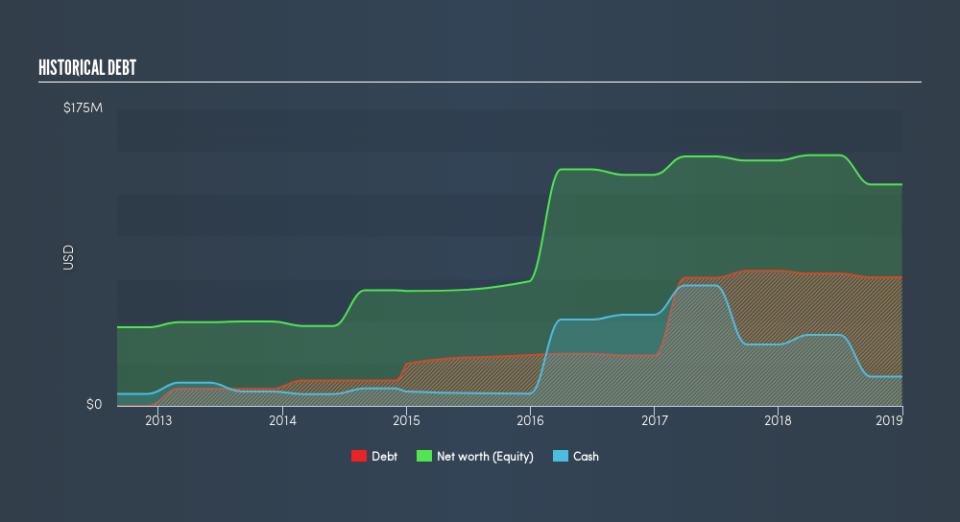Hummingbird Resources (LON:HUM) Has Debt But No Earnings; Should You Worry?

The external fund manager backed by Berkshire Hathaway's Charlie Munger, Li Lu, makes no bones about it when he says 'The biggest investment risk is not the volatility of prices, but whether you will suffer a permanent loss of capital.' So it might be obvious that you need to consider debt, when you think about how risky any given stock is, because too much debt can sink a company. Importantly, Hummingbird Resources PLC (LON:HUM) does carry debt. But the real question is whether this debt is making the company risky.
Why Does Debt Bring Risk?
Debt and other liabilities become risky for a business when it cannot easily fulfill those obligations, either with free cash flow or by raising capital at an attractive price. If things get really bad, the lenders can take control of the business. While that is not too common, we often do see indebted companies permanently diluting shareholders because lenders force them to raise capital at a distressed price. Of course, debt can be an important tool in businesses, particularly capital heavy businesses. The first step when considering a company's debt levels is to consider its cash and debt together.
Check out our latest analysis for Hummingbird Resources
What Is Hummingbird Resources's Net Debt?
The image below, which you can click on for greater detail, shows that Hummingbird Resources had debt of US$75.9m at the end of December 2018, a reduction from US$79.7m over a year. However, it does have US$17.3m in cash offsetting this, leading to net debt of about US$58.6m.
How Strong Is Hummingbird Resources's Balance Sheet?
According to the last reported balance sheet, Hummingbird Resources had liabilities of US$75.2m due within 12 months, and liabilities of US$54.4m due beyond 12 months. Offsetting these obligations, it had cash of US$17.3m as well as receivables valued at US$12.0m due within 12 months. So its liabilities total US$100.2m more than the combination of its cash and short-term receivables.
Given this deficit is actually higher than the company's market capitalization of US$95.6m, we think shareholders really should watch Hummingbird Resources's debt levels, like a parent watching their child ride a bike for the first time. Hypothetically, extremely heavy dilution would be required if the company were forced to pay down its liabilities by raising capital at the current share price. The balance sheet is clearly the area to focus on when you are analysing debt. But ultimately the future profitability of the business will decide if Hummingbird Resources can strengthen its balance sheet over time. So if you're focused on the future you can check out this free report showing analyst profit forecasts.
In the last year Hummingbird Resources managed to produce its first revenue as a listed company, but given the lack of profit, shareholders will no doubt be hoping to see some strong increases.
Caveat Emptor
Over the last twelve months Hummingbird Resources produced an earnings before interest and tax (EBIT) loss. Indeed, it lost US$5.2m at the EBIT level. Considering that alongside the liabilities mentioned above make us nervous about the company. It would need to improve its operations quickly for us to be interested in it. Not least because it burned through US$7.9m in negative free cash flow over the last year. So suffice it to say we consider the stock to be risky. For riskier companies like Hummingbird Resources I always like to keep an eye on the long term profit and revenue trends. Fortunately, you can click to see our interactive graph of its profit, revenue, and operating cashflow.
Of course, if you're the type of investor who prefers buying stocks without the burden of debt, then don't hesitate to discover our exclusive list of net cash growth stocks, today.
We aim to bring you long-term focused research analysis driven by fundamental data. Note that our analysis may not factor in the latest price-sensitive company announcements or qualitative material.
If you spot an error that warrants correction, please contact the editor at editorial-team@simplywallst.com. This article by Simply Wall St is general in nature. It does not constitute a recommendation to buy or sell any stock, and does not take account of your objectives, or your financial situation. Simply Wall St has no position in the stocks mentioned. Thank you for reading.

 Yahoo Finance
Yahoo Finance 
